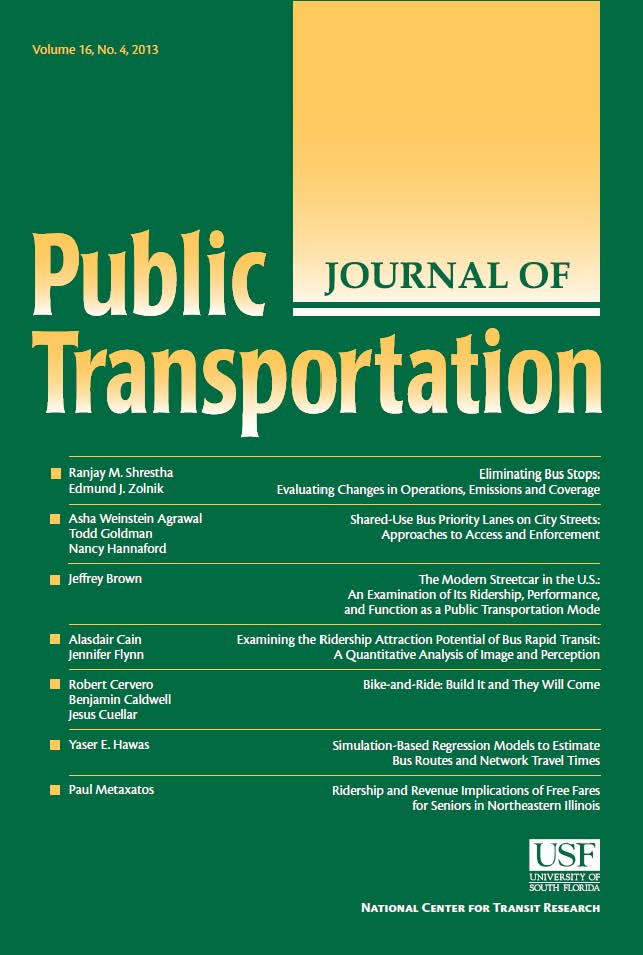Influence of tolerable, perceived, and actual travel time on trip satisfaction among Canadian older adults
IF 2
4区 工程技术
Q3 TRANSPORTATION
引用次数: 0
Abstract
As older adults cease driving, public transit can support them maintain their independence and remain connected to their communities. This population is particularly sensitive to travel times. While previous research has explored the impact of ideal and perceived travel times on satisfaction, the role of tolerable travel times—representing the maximum acceptable time threshold before satisfaction declines—has been underexplored. Understanding this relationship can provide valuable insight for improving transit experiences and meeting the mobility needs of older adults. To explore this gap, we examine how subjective (perceived and tolerable) and objective (actual) measures of travel time influence trip satisfaction among older adults. To do so, we use data from the 2023 Aging in Place Survey, a Canadian bilingual online survey, focusing on respondents who used transit at least once in the past year from Toronto, Montréal, and Vancouver (N = 731). We asses the impact of these measures of travel time on trip satisfaction through multi-level ordered probit models, accounting for both individual and regional factors. Our findings suggest that older adults are more likely to be satisfied with their trip when perceived travel time aligns with what they consider as tolerable, rather than the actual, objective trip duration. They also reinforce the strong role of previous transit experiences and perceptions on shaping future trip satisfaction. Given the link between satisfaction and continuous transit use, these findings are relevant for practitioners and policymakers seeking to improve public transit experiences for older adults and support their healthy aging.
加拿大老年人旅行满意度的可忍受、感知和实际旅行时间的影响
随着老年人不再开车,公共交通可以帮助他们保持独立,并与社区保持联系。这些人对旅行时间特别敏感。虽然之前的研究已经探讨了理想旅行时间和感知旅行时间对满意度的影响,但可容忍旅行时间(代表满意度下降之前的最大可接受时间阈值)的作用尚未得到充分探讨。了解这种关系可以为改善交通体验和满足老年人的出行需求提供有价值的见解。为了探索这一差距,我们研究了主观(感知和可容忍)和客观(实际)的旅行时间测量如何影响老年人的旅行满意度。为了做到这一点,我们使用了来自2023年老龄化调查的数据,这是一项加拿大双语在线调查,重点关注在过去一年中从多伦多、蒙塔梅和温哥华至少使用过一次交通工具的受访者(N = 731)。我们通过考虑个体和区域因素的多层次有序概率模型来评估这些旅行时间对旅行满意度的影响。我们的研究结果表明,当老年人感知到的旅行时间与他们认为可以忍受的时间一致时,而不是与实际的、客观的旅行时间一致时,他们更有可能对旅行感到满意。它们还强化了以往的交通体验和感知对塑造未来出行满意度的重要作用。考虑到满意度与持续公交使用之间的联系,这些发现对寻求改善老年人公共交通体验并支持其健康老龄化的从业人员和政策制定者具有重要意义。
本文章由计算机程序翻译,如有差异,请以英文原文为准。
求助全文
约1分钟内获得全文
求助全文
来源期刊

Journal of Public Transportation
TRANSPORTATION-
CiteScore
6.40
自引率
0.00%
发文量
29
审稿时长
26 days
期刊介绍:
The Journal of Public Transportation, affiliated with the Center for Urban Transportation Research, is an international peer-reviewed open access journal focused on various forms of public transportation. It publishes original research from diverse academic disciplines, including engineering, economics, planning, and policy, emphasizing innovative solutions to transportation challenges. Content covers mobility services available to the general public, such as line-based services and shared fleets, offering insights beneficial to passengers, agencies, service providers, and communities.
 求助内容:
求助内容: 应助结果提醒方式:
应助结果提醒方式:


